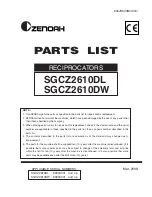
26
GB
8.4 Mounting the sliding rod holder (Fig. 6.1)
Screw the hook screw (K) for the sliding rod (L) into
the thread at upper frame and lock it with the nut.
If the sliding rod (L) is not in use, hang it on the hook
screw.
8.5 Replacement of the sawing band
Danger! Danger of injury even with sawing band at
standstill. When replacing the sawing blade, wear
gloves.
Only use suitable sawing blades
1 Release the 2 knurl screws (D) and remove the U
bracing (C) under the sawing table. (Fig. 4)
2 Open both housing doors.
3 Release the adjustment knob (9) until the sawing
blade is released.
4 Remove the sawing blade and lead it through
–
the slit in the work table,
–
the sawing band protection at the upper blade
guide,
–
the sawing band protection at the sawing hous-
ing and the table guides.
Mount a new sawing band. Check the correct posi-
tion: The teeth must point to the front side of the saw
(where the doors are).
5 Align the sawing band to the centre of the rubber
of the band edges.
6 Tighten the adjustment knob (9) until the band no
longer slides off the edges.
7 Close both housing doors.
8 Then:
–
Tighten the sawing band with adjustment knob
(9)
–
Align the sawing band with adjustment knob
(10)
–
Align the band guides
–
Conduct a test run of at least 1 minute.
–
Stop the saw, pull out the mains plug and check
the settings.
8.6 Tighten the sawing band (Fig. 8)
Danger:
Too high tension can break the band. Too low tension
can cause the driven band wheel to slip and the saw-
ing band will stop.
1 Set the upper sawing band guide (4) fully upwards.
2
Check the tension by pressing a finger halfway
between table and the upper band guide against
the side of the band. The band should not edge
down more than 3 to 5 mm.
3 If necessary, correct the tension:
–
Turning the adjustment knob (9) counter-clock-
wise increases the sawing band tension.
–
Turning the adjustment knob (9) clockwise re-
duces the band tension.
8.7 Alignment of the sawing band(Fig.8)
If the sawing band is no centred in the middle of the
rubber wheels the track must be corrected by adjust-
ing the incline of the upper band wheel:
1 Release the lock nut (N).
2 Turn the adjustment knob (10):
–
Turn the adjustment knob (10) clockwise if the
sawing band hits the front side of the saw.
–
Turn the adjustment knob (10) counter-clock-
wise if the sawing band hits the back side of
the saw.
3 Tighten the lock nut (N).
8.8 Alignment of the upper band guide (Fig. 9+10)
The upper band guide consists of:
• a compression bearing (51) (supports the sawing
band from the back side) and
• two guiding pins (53) (giving additional lateral sup-
port).
Bearing and guiding pins must be readjusted after
each band or track replacement.
Attention:
Check all bearings for wear on a regular basis. If nec-
essary replace both guide bearings at the same time.
8.8.1 Compression bearing setting(Fig. 9)
If necessary align the sawing band and tighten it.
1 Release the compression bearing adjustment
screw (50).
2 Set the compression bearing position. (51) (Dis-
tance between bearing and sawing band = 0.5
mm). If the sawing band is turned by hand it must
not touch the bearing.
3 Tighten the compression bearing adjustment screw
(50).
8.8.2 Settings of the guiding pins (Fig. 10)
1 Release the screws (52).
2 Press the guiding pins (53) together (against the
sawing band).
3 Turn the sawing band clockwise by hand several
times in order to bring the guiding pins in the cor-
rect position - both pins should slightly touch the
sawing band.
4 Tighten the screws again (52).
8.9 Alignment of the lower sawing band guide
The lower sawing band guide consists of:
• a compression bearing (supports the sawing band
from the back side) and
• two guiding pins (giving additional lateral support).
Bearing and guiding pins must be readjusted after
each band or track replacement.
Attention:
Check all bearings for wear on a regular basis. If nec-
essary replace both guide bearings at the same time.
8.9.1 Compression bearing settings (Fig. 11)
5 Set the upper sawing band guide (4) fully upwards.
6 If necessary align the sawing band and tighten it.
7 Release the clamping screw (50) of the compres-
sion bearing (51). Set the compression bearing
position. (Distance between bearing and sawing
band = 0.5 mm). If the sawing band is turned by
hand it must not touch the bearing.
8 Tighten the compression bearing adjustment screw
(50).
8.9.2 Settings of the guiding pins (Fig. 11)
1 Release the screws (52) using a hexagon key.
2 Press the guiding pins (53) together (against the
sawing band).
3 Turn the sawing band clockwise by hand several
times in order to bring the guiding pins in the cor-
rect position - both pins should slightly touch the
sawing band.
4 Tighten the screws again (52).
Summary of Contents for 39015049933
Page 2: ......
Page 3: ...1 9 Fig 1 2 3 4 5 6 7 8 10 13 11 12 Fig 4 D D C B Fig 2 A Fig 3 Fig 5 F I E J 14...
Page 5: ...Fig 11 50 51 Fig 12 53 52 52 53 8 J 5 Fig 13 6 5 Fig 14...
Page 6: ...4 6 5 4 6 Fig 15 Fig 16...
Page 7: ......
Page 19: ...19 D...
Page 43: ...43...
Page 44: ......
















































